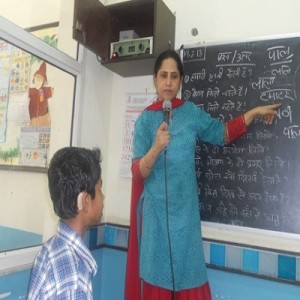MBCN employs superior Speech and Hearing techniques for differently abled
Not being able to speak is not the same as not having anything to say. – Rosemary Crossely
It is the Better Hearing and Speech month. It is time to learn to hear and speak better. Enter a Samvaad class at Mata Bhagwanti Chadha Niketan and know how the teachers and speech therapists help improve the speech and hearing ability in children. Attend a classroom session and you learn that it all starts with a Language Development Book.
Language Development through Visual Clues
The book is full of illustrations and pictorial representations that help speech and hearing impaired students form a word vocabulary. At MBCN, they are taught through pictures that depict a market scene, school, jungle or a garden. This helps them pick up words and build their vocabulary just like the way we play scrabble. They learn to make sentences based on what they see in the picture.
Apart from heightening their visual senses, the charitable school for special children offers them a therapy for improving their speaking and hearing ability. A speech therapy is derived focusing on different reasons. We came across a child who was unable to hear sounds since birth that eventually led to his speaking inability. Therapists say that his brain area that deals with hearing is damaged. The problem may occur even when that particular area of brain is still developing.
Areas of Therapy
Some of the Down Syndrome affected children have a problem of delayed speech due to their low IQ level. Therefore, we have therapies different for each of these problems. When it comes to the Hearing Impaired (HI) children, our therapists focus on the three basic areas – auditory training, language and speech. While conducting auditory training, we perform hearing assessment on the affected kids and provide them with hearing aids according to the extent of their need.
Thereafter, such kids are trained in hearing through several steps. The process includes awareness, localisation, discrimination and stabilization of sound. Then, we identify Specific Language Impairment (SLI) – the trouble of understanding what others are speaking (receptive language) and difficulty in sharing personal thoughts (expressive language). And, then there is Apraxia of Speech, where it becomes difficult to put syllables and sounds together in the right order for constructing words.
Auditory Training
During auditory training, we use hearing aids as an artificial way to allow better hearing. These devices are helpful in amplifying sounds through digital or analog way. We provide various types of hearing aids depending upon the condition of a child – mild, moderate, severe, moderately severe and profound.
Types of Aids
Initially, children with profound hearing loss are offered separate aids like Body Label, Behind-the-Ear (BTE), On-the-Ear, In-the-Ear (ITE), In-the-Canal (ITC) and Completely-In-the-Canal (CIC). All of these machines have a system of manually controlled volume matching an individual’s comfort level.
In digital, the hearing machine requires to have a default decibel (dB) setting for facilitating sound clarity at different frequencies. For instance, a child may need 60 dB at the sound frequency of 250 Hz and 70 dB at 500 Hz. Then, we correct the speaking ability through speech software. Currently, there are eight speech therapists to improve speech in children by teaching them through flash cards and Play method.
Doctored Speech Method
The Play method involves the doctored speech software in which a child (1-4 years old) gets motivated to phonate through available animated visual clues. The animated visuals are in the form of games that let a child modify his or her pitch, loudness and voicing too. The whole concept of phonetic education aims at bringing improvement in the manner and point of articulation. This is the best kind of rehabilitation treatment that can be ensured for a child with speech and hearing disability.
Spread the idea of better speech and hearing and help people understand it better.












